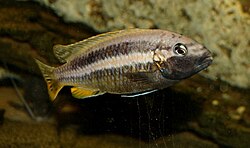| Melanochromis | |
|---|---|
 | |
| Male Golden Mbuna (Melanochromis auratus) | |
| Scientific classification | |
| Domain: | Eukaryota |
| Kingdom: | Animalia |
| Phylum: | Chordata |
| Class: | Actinopterygii |
| Order: | Cichliformes |
| Family: | Cichlidae |
| Tribe: | Haplochromini |
| Genus: | Melanochromis Trewavas, 1935 |
| Type species | |
| Melanochromis melanopterus Trewavas, 1935 | |
Melanochromis is a genus of haplochromine cichlids endemic to Lake Malawi in Eastern Africa. Ecologically, they belong to the rock-dwelling mbuna cichlids of Lake Malawi.
Melanochromis are typically small, slim but muscular fishes with lengthwise stripes of black, yellow and blue. They usually display strong sexual dichromatism.